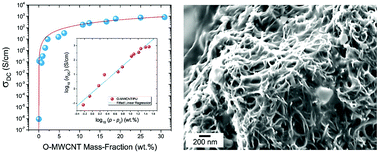Percolating conductive networks in multiwall carbon nanotube-filled polymeric nanocomposites: towards scalable high-conductivity applications of disordered systems†
Abstract
Disordered polymeric composite systems ordinarily exhibit poor bulk electronic transport properties, restricting their use to low-conductivity applications. In this work, highly electroconductive multi-walled carbon nanotube (MWCNT)/polyurethane (PU) nanocomposites were assembled via an aqueous solvent-blending method. Low percolation thresholds of 0.001 wt% and 0.093 wt% were obtained using pristine MWCNTs (P-MWCNTs) and mildly oxidized MWCNTs (O-MWCNTs), respectively. Corresponding critical values of dimensionality of 2.067 ± 0.094 and 2.304 ± 0.114 were calculated for P-MWCNT/PU and O-MWCNT/PU composites, respectively, strongly suggesting the formation of three-dimensional percolating conductive networks permeating the PU host matrix above the percolation threshold. Saturated direct current conductivities as high as 839 ± 72 S cm−1 were measured for O-MWCNT/PU composites at a filler-loading of 30.9 wt%. MWCNT/PU composite surfaces functionalized with superhydrophobic perfluoroalkyl moieties via chemical vapor deposition of (tridecafluoro-1,1,2,2-tetrahydrooctyl)trichlorosilane exhibited sessile contact angles as high as 154° without adversely affecting electroconductivity.



 Please wait while we load your content...
Please wait while we load your content...
